Mick Canning's Blog, page 51
July 21, 2016
Nepal – Everest Region
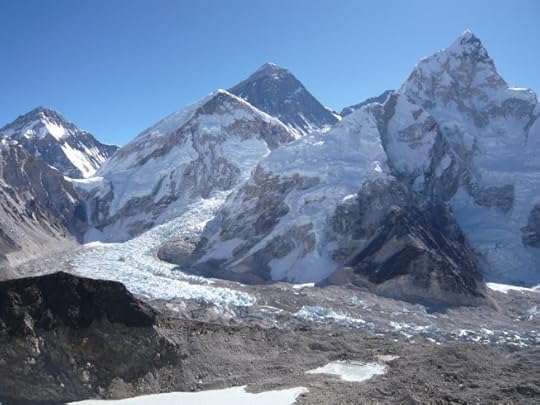
Everest from the summit of Mount Kala Pattar (5545m). In the foreground is the Khumbu Glacier, the summit of Everest is the dark peak against the central skyline, with Everest West Shoulder directly in front and Nuptse (7879m), apparently the tallest peak in the picture, because of the perspective, to the right of them. Changtse (7550m) across the border in Tibet, is to the left. Lhotse (8501m) can be glimpsed to the right of Everest, behind Nuptse.
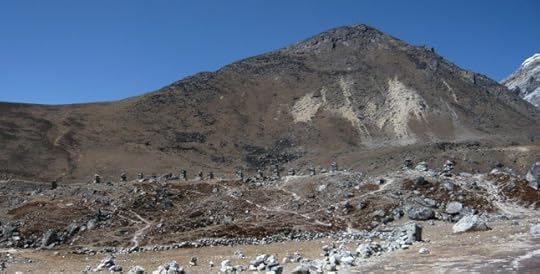
Cairns to climbers who have died on Everest, near Dhugla (Thokla). And a very sobering sight they are, too. Some have plaques, some simple inscriptions, many are anonymous. As you walk further up the Thokla Pass, you look back to this line of cairns on the ridge.
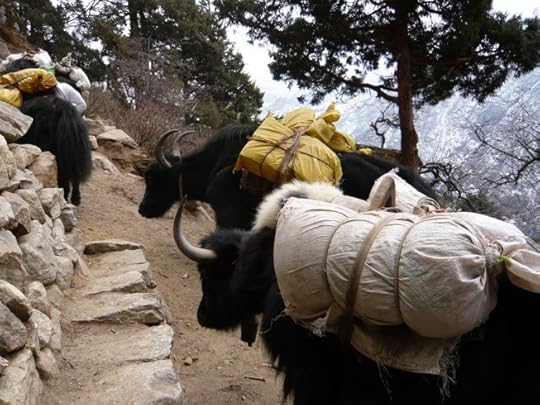
Local transport. A caravan of dzo – a cross between cattle and yaks – pass stone seats provided for travellers. Dzo tend to be both larger and stronger than yaks, an obvious advantage in an animal used for carrying heavy cargoes! They can also go down to lower altitudes than yaks, who are adapted for life at high altitudes.
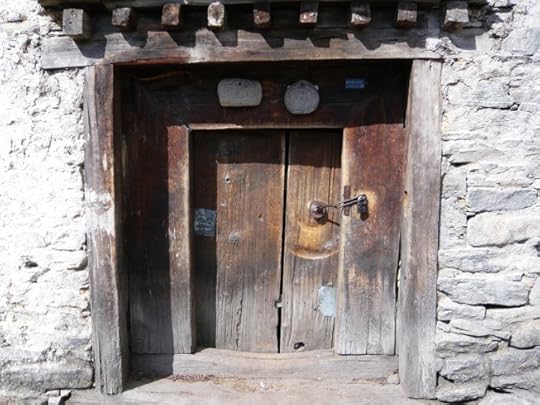
Traditional door in old house, Khumjung village, near Namche Bazaar.

Inside The temple of Tengboche monastery. Although the temple is beautiful both inside and out, my dominant memories are of sounds – the chanting of the monks at puja, when I sat in the temple one afternoon, completely unable to meditate, since I could not focus on anything except my freezing feet. Also the sounds of the bells, drums and horns that woke me at 7 o’clock in the morning – beats an alarm clock any time!
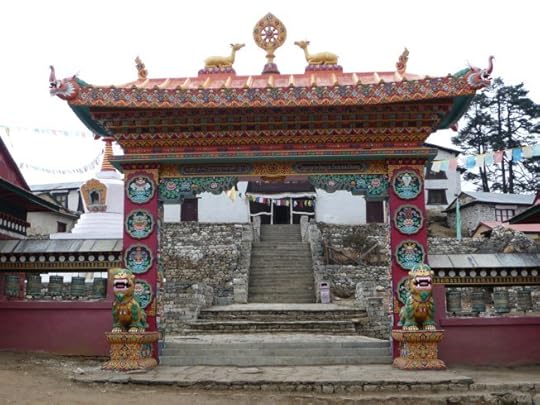
Entrance to Tengboche Monastery and Temple.

Khumbu Glacier at Lobuche.

Ama Dablam from Khumjung village. In the foreground is one of the schools built by Sir Edmund Hillary, rightly revered throughout the Sherpa community for the huge amount of work that he and his Foundation put into improving the lives of the poor in this area.

Traditional house in Khumjung.
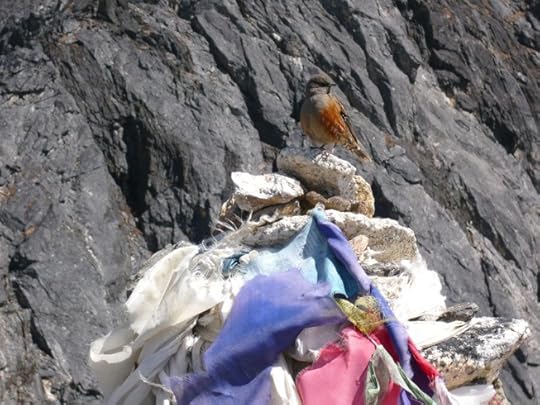
Himalayan Accentor on top of a cairn on Nagartsang Peak . This is a 5083m ‘Trekking’ Peak, ie one that can be ascended without having to use climbing skills. Apparently in America cairns are referred to as ‘ducks’, due to their shapes. So, for American bloggers: Bird on Duck.

Looking down onto the Khumbu Glacier . Although looking rather like a rubble-strewn pathway, in places one can see the bluey-green ice. Here it shows clearly around a glacial lake. As I watched, I could hear the sounds of cracking and splitting as the glacier ground it’s way incredibly slowly downhill.

Yak skull on mani stone with katas (silk scarves) and prayer flags. Cairns are not always simple piles of stones.

Yak train crossing new bridge near Phunki Drengka. The old bridge was washed away.

The old bridge. Testament to the tremendous power of floodwater.

Khumjung Gompa, where a yeti skull is kept.

The yeti skull.

Sunset, and Ama Dablam appears through the clouds.

Looking south from Dengboche.

The Spirit of the Himalaya.

Moody autumn shot just outside Lukla.

Nuptse (on left) and Everest (on right) at sunset, from Tengboche. In February 2008, when I visited, I saw nothing but clouds and mist. When I returned in October we were treated to the most marvellous sunset and sunrise.
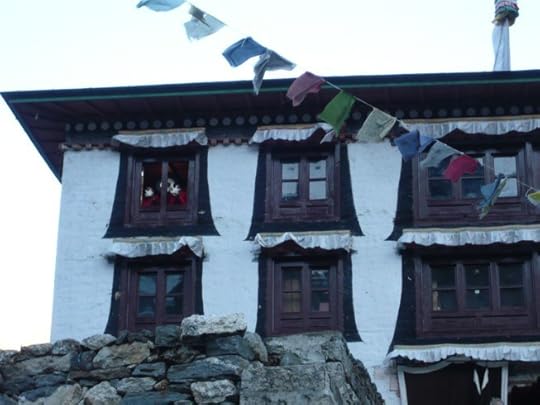
Monks blowing conch shells at morning puja, Tengboche monastery. The monks at the top left hand window are blowing the shells that make a hoarse, trumpet-like sound, during the sunrise puja.

Autumn colours.

Prayer wheels.

Ploughing a field with a wooden, dzo-drawn plough.

Namche Bazaar from above.

Carved Mani stone near Tengboche.


July 18, 2016
Coffee; my drug of choice!
At least, the first thing in the morning, it is.

I just don’t understand why it is that having a perfectly average 7 or 8 hours of sleep each night should turn me from a (relatively) normal and functioning human being, into an extra from ‘Return of the Neanderthal’ – and a non-speaking extra at that, other than the occasional ‘ug’ or snarl.
Of course, if I get less than 7 or 8 hours, then I resemble something that hasn’t even made it as far up the evolutionary ladder as the Neanderthals; some sort of fairly large and irritable beast with too many pointed teeth and a lamentable lack of patience, perhaps.
Just left to my own devices, this would not auger well for my marriage, my blood pressure, or even for the local society and environment.
But if modern medicine can work wonders in curing all sorts of previously fatal diseases, then caffeine of just the right dose seems to be the medicinal panacea for morning.
And being just a layman when it comes to the world of caffeine, I have a childlike wonder at its effects.
I am especially impressed by the strength of the espresso that you get served in cafes in Spain or France, and hence at its effectiveness. The customer crawls in and somehow climbs up onto a bar stool, using their final reserves of energy, croaks out a request for ‘espresso!’, then uses the last of their strength to lift the tiny cup to their lips…they drink…and Bingo! They leap suddenly into the air as if energised by a bolt of electricity, and then rush out of the cafe, singing lustily, to do a 16 hour day’s work.
And proper Turkish coffee, an extremely effective if much tastier substitute for asphalt, just has me in awe. Are there really people who are able to drink this each day? Every day?
Superhuman.
I doff my cap to them.
I take mine a little weaker than that, I admit, but I do like it relatively strong, and without milk or sugar – exactly the way that nature intended it.
Naturally, instant coffee just does not cut it, although I do admit than it can be effective at combating fatigue; many years ago when I worked in the Middle East, I noticed that one or two of the men who worked shifts at our company would eat the occasional mouthful of instant coffee powder when they were tired, presumably to help them get through the following few hours.
But despite that, I just have not found an instant coffee that seems drinkable. Nothing can match the real thing, for me.
And lest you fear that I am doing myself irreparable damage by flooding my system with strong coffee throughout the day, let me just say here that for me it is an early morning ritual only, and after that I drink tea (a good Darjeeling, naturally!).
But now it is lunchtime. I have got through another morning.
Thank you, coffee. Thank you.
Where’s that damned kettle?


July 14, 2016
Oh, I really can’t be bothered…
Having published ‘Making Friends with the Crocodile’, I do feel that I have succumbed to the temptation of sitting back and resting on my laurels. It seems to be quite difficult to motivate myself to write anything, and, strangely, it also seems quite difficult to motivate myself to do anything about publicising said novel.

I have tried to galvanise the other Work In Progress; my long novel ‘The Assassin’s Garden’, which already weighs in at some 110,000 words, but I seem to be very dissatisfied with anything that I write. I get too easily sidetracked from the research that I need to do, and everything that I read back seems to be somehow trite and uninteresting.
There are some short stories that I need to edit, one of them almost 15,000 words long. But do I feel like doing it? Nope.
Then there is a poem cycle that was going well…nope.
Even blogging seems to be much harder work than usual.
Is this some sort of reaction from finishing the other novel, I wonder?
But what about publicising ‘Making Friends with the Crocodile’? Surely there is plenty of incentive to do that?
Well, I have had a few reviews, and they are all very kind and generous with their praise, and I have the strangest feeling that I am so pleased with them, that they seem of more importance to me than sales.
Obviously, no sales would mean no reviews, so this doesn’t really make too much sense, but I do wonder if other writers feel this way after publishing a book.
Or could it just be because it is my first?
But, something clearly needs to be done.
I had decided to enter NaNoWriMo this year. This is National (Na) Novel (No) Writing (Wri) Month (Mo), which happens in November (No again?) and is internet based (So how come National? Search me…) and is a challenge to write 50,000 words of a novel (Gosh) in the month of November (Phew!). This is generally in the form of a first draft, to be edited later at leisure. I thought it would be fun to try, and I had begun to make a few notes in readiness.
But in a similar way to the way that my idea for ‘Making Friends with the Crocodile’ hijacked my writing last year, held a gun to my head and forced me to write it, so my ideas for this other novel have rapidly snowballed until I knew that I had to make a start on it.
And so, I now have a new work in progress.
Again it is set in India, but this time there are two main protagonists; one Westerner and one Indian, and the story will be written alternately from their Points Of View. I have pretty well worked out the details of the plot, but let’s just say at the moment that they both change a lot as a result of their meeting (I don’t do spoilers, but I do try to do teasers!).
Hopefully, this will goad me into rather more activity than I have managed in the last few weeks, including now thinking up a new idea for NaNoWriMo.


July 11, 2016
Dodgy digestion in Dharamshala
I am not sure why, but I frequently think of the room that I stayed in when I went to McCloud Ganj in 2009. It was not my best trip to India, since it was the one time that I have picked up a bad stomach bug that I could not shake off for the entire duration of my trip. I had a few days in Jaipur, the condition of my digestive system rapidly going downhill despite medication and fasting, and finally took the bus back to Delhi where I felt strangely comfortable in the familiar warren of Paharganj.
When I felt that my stomach had at least stabilised, although it was by no means cured, I decided I was well enough to go and spend a week or so in Dharamshala. Or McCloud Ganj, which is what most people mean when they mention Dharamshala. McCloud Ganj is where the Dalai Lama and many Tibetan refugees actually live; Dharamshala is a town close by. Anyway, instead of taking the bus – a twelve hour journey that I just couldn’t face – I splashed out and took a flight.
Actually, the flight was wonderful.
The plane was a twin engine prop, rather than a jet, carrying just a few passengers. If one has to travel by air, then I think that there is no nicer way of doing it. We were crossing the North Indian plains for a while, then all of a sudden the Himalaya jagged up like freshly whitened teeth from side to side across the horizon. We slowly approached, the ground beginning to rise up into hills and the towns disappearing. We passed Shimla atop a ridge, with its airport running along a second ridge, looking for all the world as though the top had been sliced off – and perhaps it had.
Eventually we came into land – a tiny airport where the aircraft taxied up to the small building, switched off, and then when we got out all was quiet. After the hum of the engines during the flight, the sudden silence with the mountains staring down at us, and the air clear and cool, was breathtaking and almost indescribably beautiful. I just wanted to stand still and drink it all in, but was eventually ushered into the terminal.
And the aircraft terminal was small enough to feel that it was built on a human scale. A few rooms and halls, and not too many people around. And even those people appeared to be in no real hurry, unlike the larger airports that I usually find myself in.
I thought immediately of Leh airport, in Ladakh. That had the same feel.
So I picked up my luggage, and went outside to get a taxi to McLeod Ganj (or Gunj).
Once in McLeod Ganj, I checked into my room at Hotel Ladies Venture. It was basic, but it was clean, had hot water, a bed with lots of blankets, a table and a chair. For RS 200/- a night I had nothing to complain about, and if you wish to read this as a recommendation, then feel free to do so.

I shall write a proper blog post on McCloud Ganj at some point, but suffice to say I did very little during the week that I was there, other than wander around and look at the mountains, read, eat and drink, and visit the Tsuglagkhang Complex; the temples and the residence of the Dalai Lama (who was out when I visited).
But my guest house room has stuck in my mind.
By the end of my second day there, I had slightly rearranged the room to get it how I wanted it. My few books were lined up on the windowsill. Various belongings were on the table. I had hung a string of prayer flags along the wall. Little touches.
I have stayed in far nicer rooms. I have enjoyed better health at other times. But every time that I feel my life is too cluttered; too full of unnecessary junk and too complicated, it is this room that suddenly springs to mind, and I’m not entirely certain why.
It might have something to do with the fact that I do travel light, and so have nothing with me but essentials plus a few books and my notebook (although I would argue that they are also essentials!).
It might have something to do with the fact that my room that week felt like a bit of a refuge, partly because I still felt unwell, although I am not entirely convinced by this since I loved the town, the people were lovely, and I was completely at ease there.
I think that it is simply symbolic of the feeling that I constantly have that I need desperately to declutter and simplify my life. I think that when feelings of stress and anxiety threaten to overwhelm me, then it is an image of a refuge. I think that it is a reminder of much that I love about India and its people.
Dammit, I need to get out there again!


July 4, 2016
Himalayan Foothills
I am going offline for a few days, since I need a bit of a break, so I will leave you with a selection of photographs from the Himalayan Foothills, Northern India. When I log on again in a few days, I’ll catch up with everyone’s blogs and comments.
By ‘Foothills’ I mean the ranges of hills and smaller mountains that guard the approach to the Himalaya proper, where the big beasties rise up to heights of over 8000m with permanent ice and snow cover. The old Raj hill stations such as Nainital and Darjeeling were built at heights of around 2000m – high by UK standards, but certainly not by Himalayan ones.

Naini Tal, Nainital Town, Northern India. Morning Light. Nainital lake, (‘naina’ is Sanskrit for eye and ‘tal’ means lake) in Hindu mythology, is one of the emerald green eyes of Sati, Shiva’s wife. This was my first view of it after getting off of the overnight bus from Delhi.

Gadhar Kunkyop Ling Gompa, Nainital. Unlike many other Himalayan towns, Nainital has no sizeable Tibetan population, and this Monastery, perched high to the North East, overlooking the lake, is the only one in Nainital and home to just seven monks.

Morning mist, Nainital.

A sea of prayer flags on Observatory Hill, Darjeeling. Darjeeling, unlike Nainital, has a large Tibetan population and many Gompas both in the town and the surrounding hills. Observatory Hill is the site of the original temple of Dorje Ling, long destroyed, but after which the town was named, once the British had persuaded the then ruler of the area, the Chogyal of Sikkim, to lease them the land to build a hill station. The hill is now home to a Hindu shrine, with the British built church of Saint Andrew close-by.
But no Gompa.

The ‘Toy Train’ stopped outside Samten Choling Gompa at Ghoom, near Darjeeling. This train runs for 51 miles from Siliguri to Darjeeling, rising a total of just over 7000 ft. It has numerous steep gradients and sharp curves, including the famous one at ‘Agony Point’ – originally the loop there was a diameter of only 59.5 ft and the train literally overhung the mountainside as it rounded the curve. All in all, quite a remarkable engineering feat and deservedly a World Heritage site.

Druk Sangak Gompa, a large Buddhist monastery on the edge of Darjeeling, West Bengal. A fairly new gompa, it was inaugurated by the Dalai Lama in 1992.

Not Chelmsford, UK, but Darjeeling, West Bengal). Many of the old British hill stations, such as Darjeeling, still retain much of their colonial character.

A clash of cultures! And what a clash. East meets west, with brass band in the park meeting the Indian Himalaya, courtesy of the Darjeeling Police Band. The band played in a bandstand on the Chowrasta, the open square at the top of Darjeeling, close to Observatory Hill. In the days of the Raj, this would, no doubt, have been familiar to all who lived there. Close your eyes and think of England…

Tea pickers, Darjeeling. Think of Darjeeling, think of tea. In the hills surrounding Darjeeling are numerous tea estates, where the job of tea picking, sorting, drying and packing goes on much as it has done for the last 150 years.

Buddhist painting on rock wall, by open air shrine, Darjeeling. As well as the larger gompas, you come across small shrines and gompas unexpectedly around odd corners everywhere.

Prayer Lags in Yumthang Valley, Northern Sikkim. This is as far north in Sikkim that you are allowed to travel, just a few miles south and west of Tibet. Everybody is still very touchy about borders.

Crossing a bridge in the Yumthang valley. It should be safe, considering the number of prayer flags!

Unnamed 6000m peaks overlooking the Yumthang Valley. We asked our guide the names of these peaks, only to be disparagingly told ‘They don’t have names. They’re less than 6000m tall.

And more prayer flags…

Young monks on a hillside, Phodong Gompa, Sikkim.

Monastery wall painting, Lachung Gompa, Northern Sikkim. Lachung Gompa is about 2km above Lachung village, at a height of about 3000m. It is not a ‘working’ gompa, the monks living down in the village rather than at the gompa, so it is generally kept locked and only used on festivals and full moon days.

Monastery door, Tharpa Choling Gompa, Kalimpong, W.B. Kalimpong, not far from Darjeeling, but 1000 metres lower, has also a large Tibetan population.

Statue of Chenrezig (Avalokiteshvara), Durpin Gompa, Kalimpong, West Bengal. Chenrezig (Tibetan) or Avalokiteshvara is the Bodhisattva (a being who has partly or completely attained the state of enlightenment) of compassion. The well-known mantra ‘Om Mani Padme Hum’ is dedicated to him.
Kalimpong market:

I watched this gentleman for some time before I approached and asked for a photo. he was rapidly serving a succession of customers at great speed, making up little paper screws of spices and powders at a tremendous rate…

…whereas this gentleman served his customers at a more leisurely pace, as if he had all the time in the world.

This gentleman was delighted to be photographed with his fine collection of Kukris. As I prepared to take the photo, he picked up a kukri and brandished it with a none too convincing snarl, to the obvious amusement of most of the people around him.

This stall-holder seemed to find it hilarious that I should want to photograph her.

This lady, on the other hand, was delighted to be photographed; volunteering eagerly when a lady on a nearby stall refused.

The Katherine Graham Memorial Chapel, in the grounds of the Dr Graham School and home, Kalimpong. Built in 1925, it looks to have materialised straight out of the Scottish Highlands. Dr Graham was a Scottish missionary, and built the home and school originally to educate the children of local tea estate workers. It now has a far broader intake.

Lake Dal, Srinagar, Kashmir. Unfortunately, it is still probably unwise to visit most of Kashmir, and things will probably remain this way for some considerable time to come. A pity, because this really is a most beautiful part of India and Pakistan. I took these photos in 1989, a very short while before the area became off-limits to tourists.

Panorama – Lake Dal, Srinagar, Kashmir). In the distance is the Hazratbal Mosque, a comparatively modern mosque, enshrining a hair of the prophet.

Hindu shrine. Near the shore of Lake Dal in Kashmir.

Houseboats around the shore of Lake Dal, Shrinagar, Kashmir. In the nineteenth century, the British, who first developed Srinagar as a hill station to get away from the stifling heat of the Indian Plains in the summer, found that the then Maharajah refused to sell them land to build houses. The solution? They built boats to live on…great, elaborate, ornate carved and decorated houseboats. These same boats, with many more recent editions, now function as floating hotels to tourists. The majority are moored not on the actual shore, but a little way off, often on the edge of small islands. This gives the local shakira (a type of small boat unique to Lake Dal) owners a chance to clean up, as a taxi service.

Shakira moored on Lake Dal.


June 30, 2016
Review: “Making friends with the Crocodile” by Mick Canning
A great review of my book by Christoph Fischer.
 I am delighted to present you my review of Mick Canning’s novel “Making Friends with the Crocodile”. Having followed Mick’s blog posts about India for some time, I was eagerly awaiting it.
I am delighted to present you my review of Mick Canning’s novel “Making Friends with the Crocodile”. Having followed Mick’s blog posts about India for some time, I was eagerly awaiting it.
The book focuses on women in rural India. “If you live near the river, you better make friends with the Crocodile” is an Indian proverb.
In the novel we get to see simple lives, where people struggle to make a living, earn a reputation and survive in a world full of crocodiles. Those crocodiles come in all shapes and forms: friends, family, strangers, laws, conventions…
Surviving isn’t easy, especially if you are a woman.
The story of Siddiqui and her family revolves largely around an unfortunate evening incident that involves her daughter in law and the friend of her husband. How people and the community respond to said incident shows the difficulties women face.
At first I didn’t…
View original post 255 more words


June 22, 2016
‘Hello again!’ *waves frantically*
Stuff gets in the way of life, as usual.
I just seem to have had no meaningful time available for the last ten days or so, which means I’ve missed putting up a couple of posts, as well as not being able to go off and read and comment on other folk’s posts. So today I’ll catch up with as many as I can, and post a few updates on my own projects. This has prompted me, however, to make a decision to change slightly how I use my time blogging.
Instead of nipping back frequently to check for replies to my post, or to my comments on other folks posts, I’m going to attempt to go on just once each day and deal with everything. I never have been very good at self-discipline, and I know that the way I use my time on the computer leads to my getting far less actual writing done than I should.
Prevarication, you could say.
So…firstly, I have received some lovely reviews for ‘Making Friends with the Crocodile‘, which rather makes it all worth while! I hadn’t realised how important the reviews would feel, but they do more than the actual sales figures to make me feel good about the book.
So a heartfelt ‘Thank you’ to those who have written those reviews!
Next, some of you will probably have noticed that I now have a link on my sidebar to a site where I sell photographs.

Bob Ramsak, a gifted photographer and reporter who blogs at ‘Piran Cafe‘ – http://www.pirancafe.com/ recommended this site, and I have begun to upload a few photographs there over the last few days. Hopefully, I will get a whole load more up in the future, especially ones that I have put up previously in this blog, but there are some forty or fifty up at the moment to start with.
I do not know how their particular algorithms work, but it seems likely that the more ‘views’ a picture gets, the more likely it is to feature on the front page of searches. I noticed that when I browsed the site, the pictures that came up first when I did a search, were the ones that had had a large number of views. Of course, I also realise that it is possible that the reason that they have more views, is that they come up first in the searches.
But if any of you have a few moments to spare, I’d be hugely grateful if you went and had a look, and then clicked on a few photos. The address is https://www.picfair.com/mickcanning
Finally, I also have a site where you can find a lot of my paintings. This is also on the sidebar, and is https://www.artgallery.co.uk/artist/m...

But that’s probably more than enough self-promotion for today!
I had contemplated blogging on the EU referendum taking place tomorrow, but there is so much vitriol sloshing around at the moment that I’ve decided to keep out of it, at least on this blog.
And so I’ll leave it there, and come back with a brand new sparkling and shiny post in a few days time.
Unless more stuff gets in the way, of course.


June 13, 2016
We Are So Strong
At that time of the year marked out by the Christian calendar as a time of feasting and rejoicing, a traveller arrived at this loneliest of spots, seeking perhaps no more than shelter for the night. The weather was cold; the daylight hours were short and, at this place, inclined to be dark. The wind had ceased when he arrived, but the air seemed to wrap itself thickly around the rocks and trees in the shallow dell, and the low clouds hung like the tattered and fraying old tapestries in a gloomy cathedral that I have heard spoken of by other travellers, during the long, long years of my life. There is no work by man in this place, but the gently sloping sides and the strong, ancient trees might give some protection from the weather.

The traveller was old. I could see that he had lived through many summers and winters, and was approaching the nadir of his life. He had displayed an admirable tenacity in reaching this place on foot, and I was inclined to respect him for this. The path through the hills would have led him many long miles since he last passed through a village of men. As he must be his own beast of burden, he did not carry very much with him. A single bag, a sack I suppose, was dropped to the ground and he followed it slowly, joints and muscles struggling with the effort. For a while, which did not seem very long to me, he sat beside this burden, his cloak pulled tightly around him, and then as the darkness began to close in further, he opened the sack to remove a blanket and a few other items that I could not recognise.
He then spent a while gathering together many of the dead twigs and branches that were scattered around this place, which I did not mind, although it was obvious to me what he wanted them for. There was a storm coming that night, although it was most unlikely that he would know this, and he would want fire against the cold and the rain. He worked steadily as dusk fell, preparing everything that he would need, and then there was a clicking and scraping of metal against stone, and sparks flared and died suddenly in the night; tiny cousins of the stars that the Creator on occasion sees fit to make fall to earth. Soon, I saw some of these stars lingering and growing amongst the tinder, and the old man’s face glowed orange as he knelt down to blow them gently, teasing the tiny flames into life.
He did not seem to eat, but later he drank something from a small bag made from animal skin that caused him to relax and he leaned back against the trunk, his blanket now wrapped around him over his cloak, staring into the depths of the firelight. He awoke as the storm began to rage, and I was surprised at how quickly he got to his feet. He seemed to work madly, feverishly, piling branch after branch upon the fire until the flames swirled around in the wind, high and hot and strong, flickering in turn out into the darkness, and then licking against the tree trunks or surging up into the canopy. Still he piled on the wood that he had gathered.
The iron discipline that bonds us all together can do nothing to prevent us from feeling hatred and fear, and it was this, our eternal fear of fire and our hatred of these creatures which loosened these bonds for a moment. It was only a fleeting moment, and then the world settled back into its eternal rhythm. All that had changed was the branch that pinned the old man to his pyre.
We are so strong.


June 9, 2016
Kathmandu, Nepal
I’m going to start with a selection of pictures from Kathmandu, capital of Nepal.
All of these pictures were taken before the dreadful earthquakes of last year, and I do know that some of the buildings in these pictures (especially in Durbar Square) were sadly destroyed.
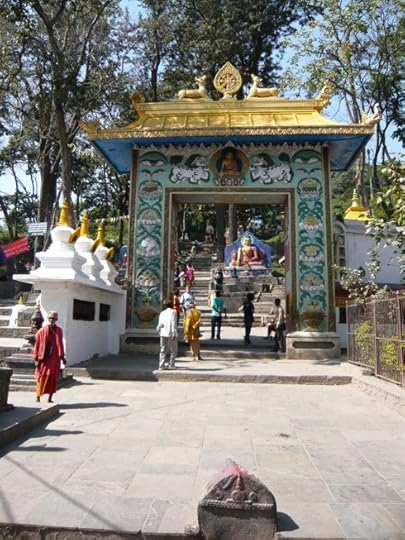
The entrance to Swayambunath. Swayambunath is the main Tibetan Buddhist site of Kathmandu. Sitting on top of a hill overlooking Kathmandu, it comprises temples, stupas and various other buildings, including a couple of Hindu shrines. Here, a Hindu holy man lurks in ambush, ready to dab a tikka mark on the forehead of (especially) western tourists and demand rupees for the privilege.
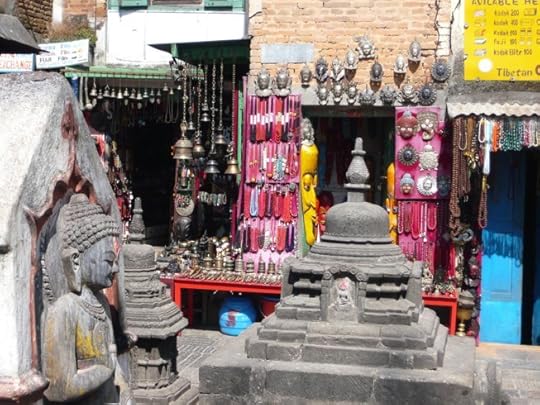
The sacred and the secular at Swayambunath. In Nepal, as in India, it is almost impossible to visit a religious site without Mammon getting a good look in. Here, in the main Buddhist site of Kathmandu, everything from yak bells to masks.
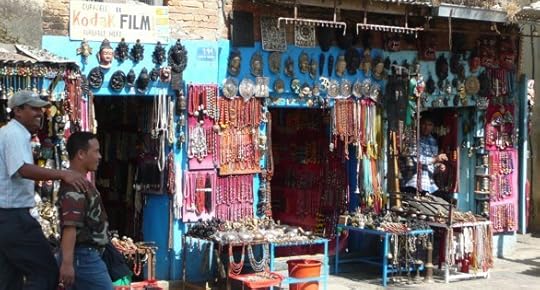
‘One day, my boy, all this will be yours’ – just as long as you have enough money and all the time in the world to bargain hard. More shops – seriously colourful, seriously prepared to sell you anything. And having said that, the hard sell is a world removed from India. It almost feels as though there is no pressure at all. In Nepal, you feel you can relax again, especially if you have just travelled there from India.
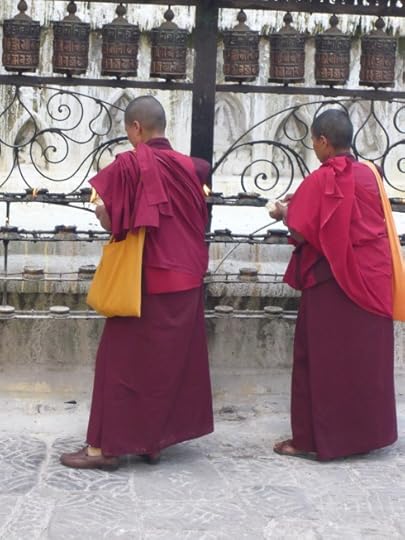
Nuns lighting butter lamps beneath a row of prayer wheels at Swayambunath.

Hindu puja at Swayambunath. Probably a private ceremony at the request of the beneficiary, either for good luck in general or with a particular goal in mind (e.g. birth of a son, successful business venture.)
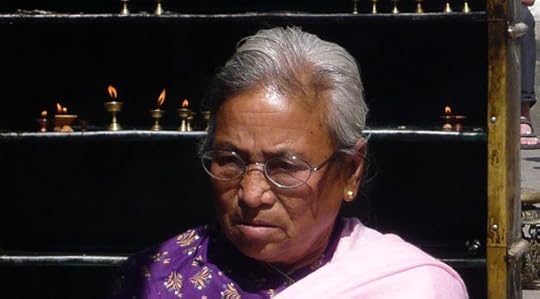
Portrait of a Hindu lady.
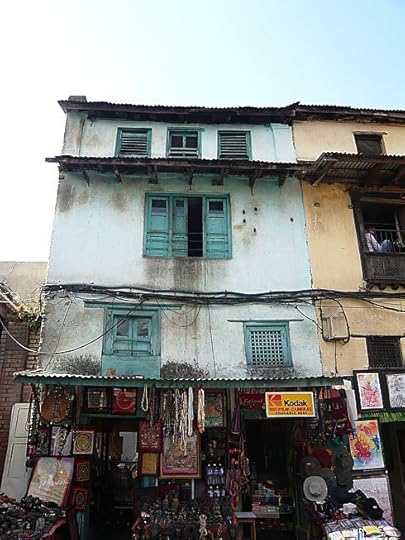
Tourist shop in the Swayambunath complex.
Buildings in Durbar Square. Durbar (or ‘Palace’) Square is the heart of the old town and the area where the Kings used to live in the 18th and 19th centuries. In contrast to Swayambunath, this area is entirely Hindu, reflecting the vast majority of the lowland Nepali population.
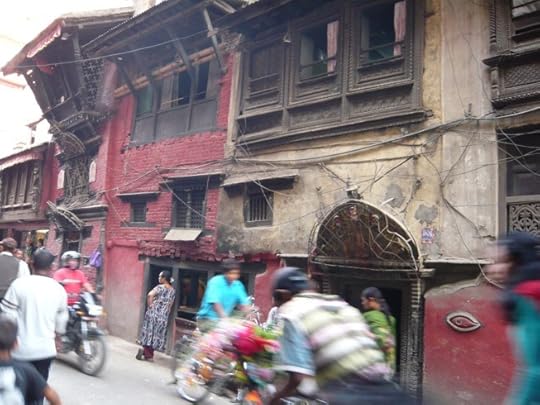
Side street in Thamel, Kathmandu. The lovely old buildings…beautiful wood carvings…collapsing brickwork…wiring all over the place…speed…calm…old and new…………the only things I can’t bring you are the sounds and smells…you must imagine them for yourselves. Coming soon, scratch and sniff websites!!!
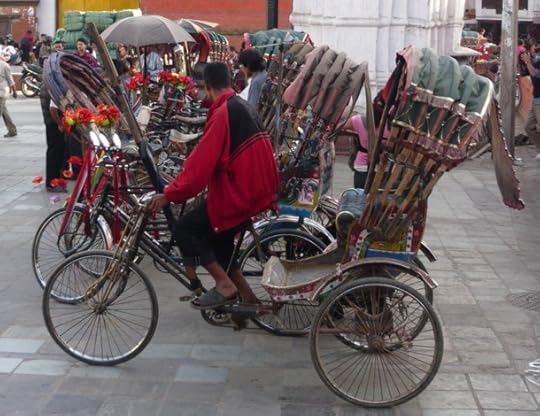
Bicycle rickshaws awaiting customers in Durbar Square.

Balloon seller and hopeful customer, Durbar Square.

Kala Bhairab – an image of Shiva in his most fearsome aspect. Wearing a garland of skulls, the six armed Kala Bhairab tramples a corpse, symbolic of ignorance. Carved originally from a single stone, it was set up by Pratap Malla, king in the 17th century. He was a pious Hindu, but interested in the arts and tolerant of other religions. He even restored much of Buddhist Swayambunath. It is said that telling a lie while standing before Kala Bhariab will bring instant death. It was once used as a form of trial by ordeal.
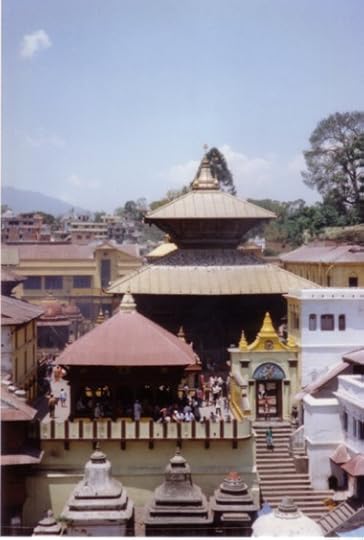
Pashupatinath, on the Eastern side of Kathmandu, is the holiest of the Hindu sites in the city. It is the temple of Shiva, on the Bagmati river and hence it includes the ghats, the most widely used place of cremation for Hindus in Kathmandu, indeed, in Nepal.


June 5, 2016
The Book is Released – Hurrah!
‘Making Friends with the Crocodile‘ is now released!


Kindle edition Paperback edition
Anyone who has already pre-ordered it on Kindle / Amazon should have received it by now, and in countries where there is no pre-order facility, such as India, the Kindle edition is also now available to buy.
The paperback is available from the Amazon.com, Amazon.ca, Amazon.co.uk and Amazon.eu sites only – this is a quirk of Amazon – but can also be ordered from the estore at CreateSpace, at the following link:
https://www.createspace.com/6301808
And now, I wait to see what people think of the book, with a considerable amount of nervousness.
If you do buy a copy, please consider leaving a review either at Amazon, or on Goodreads, if you are a member (better still, at both!). Reviews are genuinely the lifeblood of a writer, and do help to sell books.
Finally, the blurb again…
‘Siddiqa was only just into her teens when she was forced to leave her home to live with her new husband and his family in another village. The years have passed, and now Siddiqa has three children of her own. Her grown up son has brought his new wife, Naira, to live with them, so Siddiqa is no longer the lowliest in the household, for she has a daughter-in-law.
Life in rural India is particularly harsh for women. This novel explores themes of female oppression and tradition and asks whether the next generation will find life any easier.’






